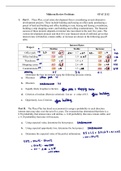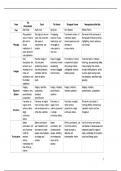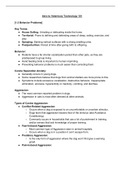-for sections with the dividers, they are the rationale for the questions on the edapt Nursing Care: Complex Intracranial and Neurologic Alterations
Nursing Care: Complex Intracranial & Neurological Alterations
Intracranial regulation is the body’s ability to control blood and cerebral spinal fluid flow throughout the brain and spinal cord. A delicate system of nerve fibers senses the increases and decreases in pressure and flow and adjusts to maintain homeostasis.
Any type of injury or abnormality can cause an imbalance, requiring the nervous system to adjust. In some cases, adjustment isn’t possible, and the body requires outside intervention to bring the body back to its normal state.
Cerebral perfusion pressure is the mean arterial pressure minus the intracranial pressure. For this client, the answer is 78 mmHg. In this case, the calculation is 120 (MAP) – 42 (ICP) = 78 (CPP).
Significantly elevated intracranial pressure leads to bradycardia, irregular respirations, and widening blood pressure measurements. This is also known as Cushing’s triad and an
indication of impending cerebral herniation. oBloody ear drainage suggests a basilar skull fracture. Cold and clammy skin below the neck suggests symptoms of autonomic dysreflexia.
The best tool to measure and record a client’s level of consciousness is the Glasgow coma scale (GCS). oThe memory impairment screen, mini-mental status exam, and Montreal cognitive
assessment measure memory, cognition, and function. They do not specifically describe the level of consciousness.
The Balance of Cerebral Spinal Fluid and Blood
Intracranial pressure fluctuates whenever brain tissue, cerebrospinal fluid, or blood pressure change. For small changes, the body can compensate by increasing or decreasing blood pressure or changing the amount of flowing cerebral spinal fluid. This process is called intracranial regulation. The amount of pressure required for the brain to work is measured using cerebral perfusion pressure (CPP).
An alteration in intracranial regulation occurs when there are unexpected changes in mass caused
by either an increase in brain tissue (e.g., tumor) or increased swelling from an inflammatory response. This can occur slowly (e.g., brain tumor) or quickly (e.g., meningitis, bleeding). Changes in the amount of brain tissue, cerebrospinal fluid, or blood can increase or decrease intracranial pressure. When intracranial pressure goes up or down, the client can develop signs or
symptoms of decreased brain perfusion. Special care is needed when caring for clients with altered cranial regulations, including:
Advanced monitoring is used to measure intracranial pressures closely.
Drains and other devices may be used to reduce this pressure through cerebral spinal fluid
drainage.
Medications, artificial ventilation, and a medically induced coma are additional ways in which alterations in alterations in intracranial regulation can be managed.
Intracranial Pressure
Intracranial monitoring can be done in complex healthcare environments with a catheter placed inside the skull. The continuous measurement determines possible elevated pressures or changes in brain temperature. Here are some common devices used to monitor and/or adjust intracranial pressures:
Intraventricular Catheter
This is the most accurate and is done with a flexible tube inserted into the lateral ventricle in the brain. This device can also be used to remove excess cerebral spinal fluid (CSF) to lower intracranial pressure (ICP).
Subdural Screw (or Bolt)
This device can be inserted quickly and is composed of a hollow screw inserted through a hole drilled into the skull. The sensor reads the pressure in the subdural space.
Epidural Sensor
This is inserted between the skull and dura mater. This is the least invasive way to measure, but it cannot be used to drain excess CSF fluid.
Here are normal measurement ranges for intracranial pressures:
Mean arterial pressure (MAP) is 70 to 100 mmHg
Intracranial pressure (ICP) is 5 to 15 mmHg
Cerebral perfusion pressure (CPP) is 60 to 80 mmHg
!https://cdn.brandfolder.io/74235FBJ/at/kqngxpt5wx93xb5rrsttqnh/ICP-monitoring_57-7.png
NOTE: Because the brain is a closed container, the worst complication of altered intracranial regulation is herniation. Herniation occurs when the pressure inside the skull is so severe it forces the brain stem through the hole in the bottom of the skull. This results in death or severe brain damage.
Intracranial Monitoring
Along with monitoring intracranial pressure, other measurements that may be used in complex environments to measure brain information include:
blood flow
oxygenation
metabolism
continuous electroencephalographic monitoring
Spinal Cord Injury
Injury to the spinal cord is another important neurological alteration addressed acutely in a complex health environment.
The spinal cord can be bruised, punctured, or severed. The spinal cord runs from the top of the neck and ends between the first and second lumbar vertebrae, with further nerve roots going out to the ends of the extremities. Any damage at any point of the spine causes symptoms beyond the
point of damage.
If the spinal injury is in the neck, the respiratory system is affected.
If the injury occurs above the thoracic vertebrae T6, there can be cardiovascular signs including: obradycardia
ohypotension
othe inability of veins and arteries to constrict
oblood pressure changes associated with the position
Spinal injury in the thoracic vertebrae can cause bowel and/or urinary problems, including: ourinary retention
oconstipation
oparalytic ileus
ofecal impaction
!https://cdn.brandfolder.io/74235FBJ/at/2m5g233wsx7stvfr3n59nh3t/
NR105_C118_Spinal_Nerves_Image.jpg
Acute Spinal Cord Injury
The location of a spinal cord injury determines the symptoms a client experiences. If the motor portion of the spinal cord is severed, the client will experience paralysis and possible organ-
related problems. Injury to the sensory portion of the spinal cord will cause paresthesia (numbness and tingling). Additional organ systems may be involved. For example, an injury at the thoracic spine at level T6 can also cause severe constipation, fecal impaction, or paralytic ileus. Preventing these complications is an important part of nursing care for someone with a spinal cord injury.
Inflammatory response exacerbates symptoms for 24 to 48 hours after. This is one rationale for immediate steroid administration to reduce additional damage caused by inflammation. Nerve fibers can regenerate in cases of partial injury, but this can take up to a year.
C1-C3 Injury
High quadriplegia: Paralysis of the neck and below with inability to breathe or cough and requires a ventilator to survive
C4 to C6 Injury
High quadriplegia: Paralysis of the neck and below with mild to significant respiratory effects
C6 Injury
Low quadriplegia: Paralysis of the neck and below with mild respiratory effects ****
T1 to T12 Injury
High paraplegia: Paralysis of some arm and hand muscles and below with cardiovascular and gastrointestinal effects
L1 to L5 Injury
Low paraplegia: Paralysis of pelvis and below with bladder and bowel effects
Client History Affecting Intracranial Regulation and Neurologic Alterations
Altered intracranial regulation or other neurologic alterations can be related to different causes. Here are some cues from the client's history that may indicate intracranial regulation issues.
Past Medical History
Head injury (previous damage)
Brain hematoma (epidural, subdural, or subarachnoid)
Cerebral vascular accident (resulting in brain edema from dead brain tissue)
Ruptured blood vessel in the brain (cerebral hemorrhage)
Overproduction of cerebral spinal fluid (pseudotumor cerebri)
Inflammation or infection in the meninges (lining of the brain and spinal cord)
Vertebral fractures
Osteoporosis
Nursing Care: Complex Intracranial & Neurological Alterations
Intracranial regulation is the body’s ability to control blood and cerebral spinal fluid flow throughout the brain and spinal cord. A delicate system of nerve fibers senses the increases and decreases in pressure and flow and adjusts to maintain homeostasis.
Any type of injury or abnormality can cause an imbalance, requiring the nervous system to adjust. In some cases, adjustment isn’t possible, and the body requires outside intervention to bring the body back to its normal state.
Cerebral perfusion pressure is the mean arterial pressure minus the intracranial pressure. For this client, the answer is 78 mmHg. In this case, the calculation is 120 (MAP) – 42 (ICP) = 78 (CPP).
Significantly elevated intracranial pressure leads to bradycardia, irregular respirations, and widening blood pressure measurements. This is also known as Cushing’s triad and an
indication of impending cerebral herniation. oBloody ear drainage suggests a basilar skull fracture. Cold and clammy skin below the neck suggests symptoms of autonomic dysreflexia.
The best tool to measure and record a client’s level of consciousness is the Glasgow coma scale (GCS). oThe memory impairment screen, mini-mental status exam, and Montreal cognitive
assessment measure memory, cognition, and function. They do not specifically describe the level of consciousness.
The Balance of Cerebral Spinal Fluid and Blood
Intracranial pressure fluctuates whenever brain tissue, cerebrospinal fluid, or blood pressure change. For small changes, the body can compensate by increasing or decreasing blood pressure or changing the amount of flowing cerebral spinal fluid. This process is called intracranial regulation. The amount of pressure required for the brain to work is measured using cerebral perfusion pressure (CPP).
An alteration in intracranial regulation occurs when there are unexpected changes in mass caused
by either an increase in brain tissue (e.g., tumor) or increased swelling from an inflammatory response. This can occur slowly (e.g., brain tumor) or quickly (e.g., meningitis, bleeding). Changes in the amount of brain tissue, cerebrospinal fluid, or blood can increase or decrease intracranial pressure. When intracranial pressure goes up or down, the client can develop signs or
symptoms of decreased brain perfusion. Special care is needed when caring for clients with altered cranial regulations, including:
Advanced monitoring is used to measure intracranial pressures closely.
Drains and other devices may be used to reduce this pressure through cerebral spinal fluid
drainage.
Medications, artificial ventilation, and a medically induced coma are additional ways in which alterations in alterations in intracranial regulation can be managed.
Intracranial Pressure
Intracranial monitoring can be done in complex healthcare environments with a catheter placed inside the skull. The continuous measurement determines possible elevated pressures or changes in brain temperature. Here are some common devices used to monitor and/or adjust intracranial pressures:
Intraventricular Catheter
This is the most accurate and is done with a flexible tube inserted into the lateral ventricle in the brain. This device can also be used to remove excess cerebral spinal fluid (CSF) to lower intracranial pressure (ICP).
Subdural Screw (or Bolt)
This device can be inserted quickly and is composed of a hollow screw inserted through a hole drilled into the skull. The sensor reads the pressure in the subdural space.
Epidural Sensor
This is inserted between the skull and dura mater. This is the least invasive way to measure, but it cannot be used to drain excess CSF fluid.
Here are normal measurement ranges for intracranial pressures:
Mean arterial pressure (MAP) is 70 to 100 mmHg
Intracranial pressure (ICP) is 5 to 15 mmHg
Cerebral perfusion pressure (CPP) is 60 to 80 mmHg
!https://cdn.brandfolder.io/74235FBJ/at/kqngxpt5wx93xb5rrsttqnh/ICP-monitoring_57-7.png
NOTE: Because the brain is a closed container, the worst complication of altered intracranial regulation is herniation. Herniation occurs when the pressure inside the skull is so severe it forces the brain stem through the hole in the bottom of the skull. This results in death or severe brain damage.
Intracranial Monitoring
Along with monitoring intracranial pressure, other measurements that may be used in complex environments to measure brain information include:
blood flow
oxygenation
metabolism
continuous electroencephalographic monitoring
Spinal Cord Injury
Injury to the spinal cord is another important neurological alteration addressed acutely in a complex health environment.
The spinal cord can be bruised, punctured, or severed. The spinal cord runs from the top of the neck and ends between the first and second lumbar vertebrae, with further nerve roots going out to the ends of the extremities. Any damage at any point of the spine causes symptoms beyond the
point of damage.
If the spinal injury is in the neck, the respiratory system is affected.
If the injury occurs above the thoracic vertebrae T6, there can be cardiovascular signs including: obradycardia
ohypotension
othe inability of veins and arteries to constrict
oblood pressure changes associated with the position
Spinal injury in the thoracic vertebrae can cause bowel and/or urinary problems, including: ourinary retention
oconstipation
oparalytic ileus
ofecal impaction
!https://cdn.brandfolder.io/74235FBJ/at/2m5g233wsx7stvfr3n59nh3t/
NR105_C118_Spinal_Nerves_Image.jpg
Acute Spinal Cord Injury
The location of a spinal cord injury determines the symptoms a client experiences. If the motor portion of the spinal cord is severed, the client will experience paralysis and possible organ-
related problems. Injury to the sensory portion of the spinal cord will cause paresthesia (numbness and tingling). Additional organ systems may be involved. For example, an injury at the thoracic spine at level T6 can also cause severe constipation, fecal impaction, or paralytic ileus. Preventing these complications is an important part of nursing care for someone with a spinal cord injury.
Inflammatory response exacerbates symptoms for 24 to 48 hours after. This is one rationale for immediate steroid administration to reduce additional damage caused by inflammation. Nerve fibers can regenerate in cases of partial injury, but this can take up to a year.
C1-C3 Injury
High quadriplegia: Paralysis of the neck and below with inability to breathe or cough and requires a ventilator to survive
C4 to C6 Injury
High quadriplegia: Paralysis of the neck and below with mild to significant respiratory effects
C6 Injury
Low quadriplegia: Paralysis of the neck and below with mild respiratory effects ****
T1 to T12 Injury
High paraplegia: Paralysis of some arm and hand muscles and below with cardiovascular and gastrointestinal effects
L1 to L5 Injury
Low paraplegia: Paralysis of pelvis and below with bladder and bowel effects
Client History Affecting Intracranial Regulation and Neurologic Alterations
Altered intracranial regulation or other neurologic alterations can be related to different causes. Here are some cues from the client's history that may indicate intracranial regulation issues.
Past Medical History
Head injury (previous damage)
Brain hematoma (epidural, subdural, or subarachnoid)
Cerebral vascular accident (resulting in brain edema from dead brain tissue)
Ruptured blood vessel in the brain (cerebral hemorrhage)
Overproduction of cerebral spinal fluid (pseudotumor cerebri)
Inflammation or infection in the meninges (lining of the brain and spinal cord)
Vertebral fractures
Osteoporosis










